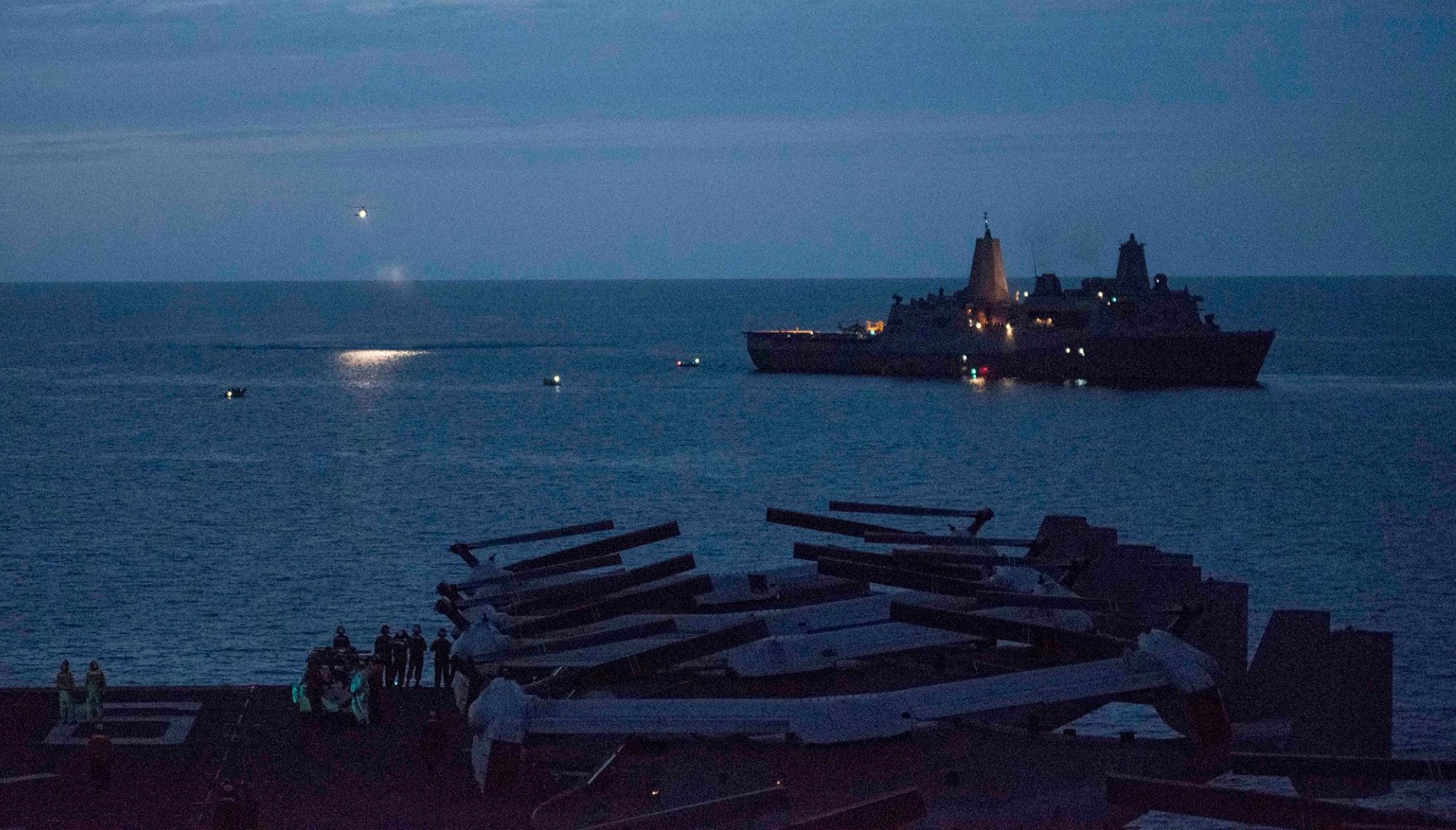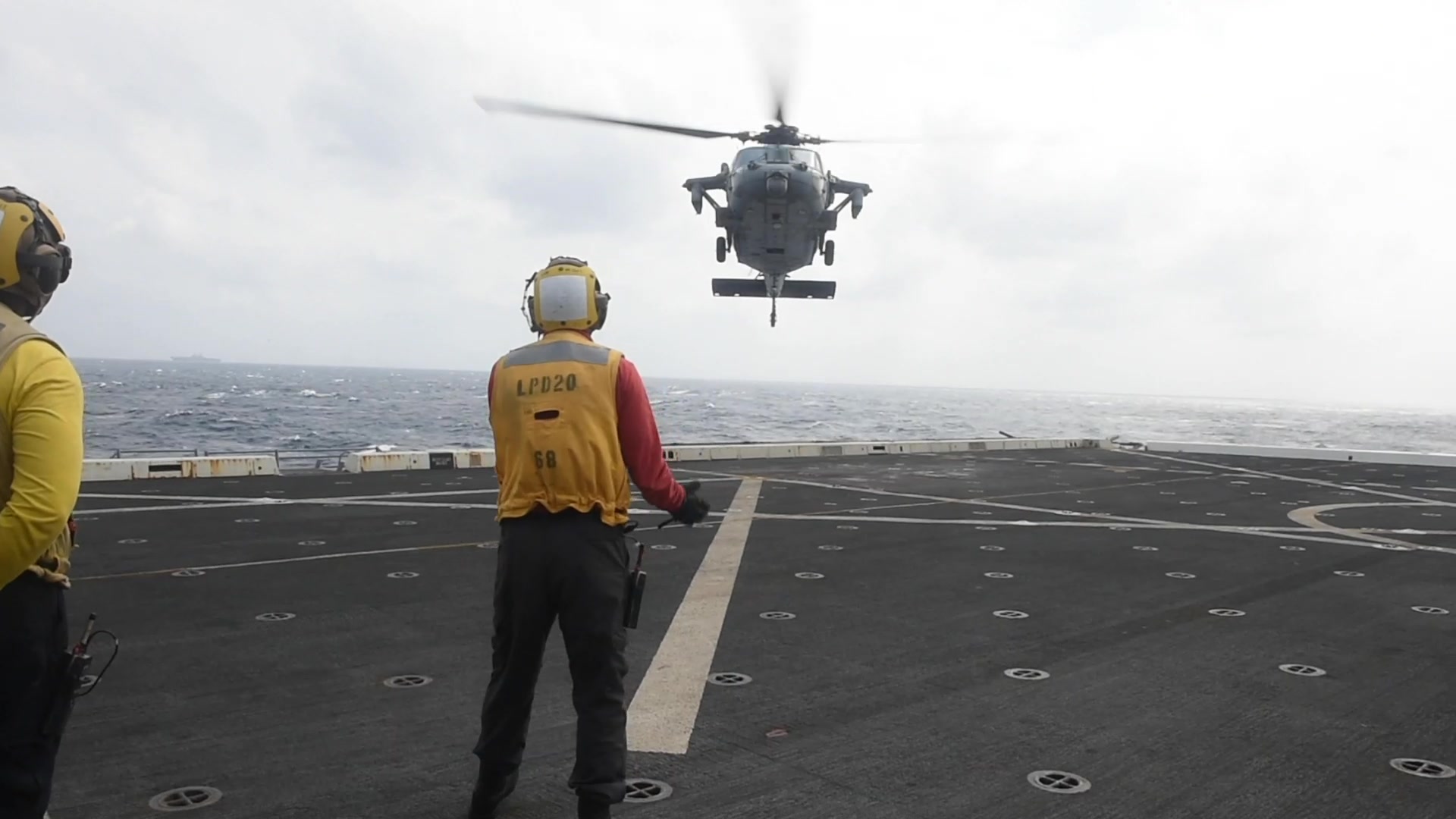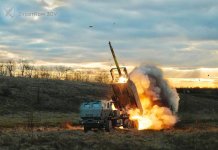On August 5, 2017, an MV-22B Osprey from Marine Medium Tiltrotor Squadron 265 crashed while attempting to land on USS Green Bay (LPD-20). For the first time, a video of that crash is now making rounds on social media.
The US warship was operating near Queensland, Australia, at the time. The video appears to show the aircraft proceeding usually as it approaches the flight deck of the San Antonio class amphibious transport dock ship. Then the aircraft suddenly drops, dramatically slamming the deck with the nacelle of the left engine.
From the area of the ship’s hangar bay, the sailor watching the landing realizes how dire the situation has become and starts running before the clip ends.
These crashes can be very dangerous on amphibious warships because other aircraft are often very close by, possibly carrying fuel or weapons.
The aircraft’s rotor blades could particularly sustain significant damage if they collide with the deck and shatter into large pieces of extremely fast shrapnel that have the potential to split an object or an aircraft in half.
Also, the Osprey in question was carrying fuel.
What Does The Investigation Report Say?
USNI News published a report on the crash investigation board’s findings on May 21, 2018. The investigation describes it as a problematic but safe mission.
The Marine Corps determined the aircraft crashed due to too much downwash and a lack of thrust to maintain its hover, but a Defense Department official told USNI News the aircraft might also have been carrying too much weight.
The official said that Naval Air Systems Command engineers have since examined the impact of downwash on a landing aircraft and the amount of power the Osprey needs to overcome that downwash and land safely.
They have also made some adjustments regarding the amount of weight an Osprey may carry on approaching a US ship at sea to ensure it has the power it needs to land, said the report.
The investigation report makes it abundantly clear that nobody was to blame for the incident and that all three personnel died in their duties, not due to misconduct.
The Osprey participated in a mission that included a simulated embassy reinforcement, a non-combatant evacuation mission, a mass casualty drill, and logistics movements as part of a three-aircraft formation.
“On the day of the crash, the mishap Osprey flew from amphibious assault ship USS Bonhomme Richard (LHD-6) to the shore at Raspberry Creek to insert embassy reinforcement personnel, back to the ship to refuel, to nearby USS Ashland (LSD-48) to deliver cargo and a passenger, back to Bonhomme Richard, participated in a mass casualty drill while aboard the ship, delivered mass casualty personnel ashore to Raspberry Creek.
It then returned with other passengers back to Bonhomme Richard, made one more run to Raspberry Creek and back to the amphibious ship, and then finally made its last trip to Raspberry Creek to pick up non-combatant evacuation personnel before heading to Green Bay, where the fatal mishap occurred,” the report explained.

The Osprey received instructions from the ship’s air traffic controllers because it initially had problems connecting to the Tactical Air Navigation signal as it approached Green Bay.
The Osprey changed its radio frequency to the launch and landing frequency as it made its final approach. According to the report, the aircraft was planned to land in Spot 5 on Green Bay and did follow the proper protocol.
The report stated that the pilot “recognized and attempted to correct a 200-300 foot per minute rate of descent with an application of power using the Thrust Control Lever.”
“The pilot and copilot – 1st Lt. Benjamin Cross, who died in the crash – could not stop the descent and took several actions, including moving the Osprey’s nacelles forward. The left nacelle struck the Green Bay flight deck, and the Osprey moved forward along the starboard side until the plane hit a steel stairway.”
The impact of the collision crushed the cockpit, breaking the pilot’s hip and leg inside, and the left proprotor blades damaged the flight deck and a nearby helicopter. The plane then plummeted 30 feet into the water, where a hole in the cockpit caused it to flood quickly. Except for three people, everyone on board survived the crash.
Other Crashes
The incident’s similarity to a less severe incident that happened on board USS New Orleans in 2015 is covered in more detail in the USNI News report, along with the conclusions of the investigations and how Osprey operations were modified after the crash.
Nevertheless, the tilt-rotor still has its critics even though the Osprey has had a stellar career after a very turbulent and drawn-out development. The main criticism of this aircraft development stems from the fact that the project has proven to be very expensive.
The project’s development costs soared, from a $68.7 million design contract in 1983 (the aircraft made its first flight in 1989) to $29.1 billion for research and procurement in 2009.
The average price per aircraft was once estimated to be $83.7 million. Some projections place the total cost at $56 billion and the cost per unit at $100 million by 2012.

In contrast, the price of a Black Hawk combat helicopter variant ranges from $20 million to $40 million. The aircraft recently experienced a few incidents as well. In March, an MV-22 crash in Norway claimed four lives.
In June 2022, another Marine Osprey crashed near El Centro, California, killing all five people on board, as previously reported by the EurAsian Times. The aircraft has proven to be one of the US military’s most effective assets.
The aircraft is critical for US military operations, particularly in the challenging maritime environment. The V-22 in all of its configurations is proving to be especially helpful as the US military keeps shifting its focus to the Indo-Pacific region.
- Contact the author at ashishmichel@gmail.com
- Follow EurAsian Times on Google News




